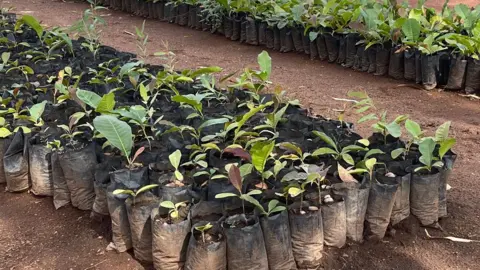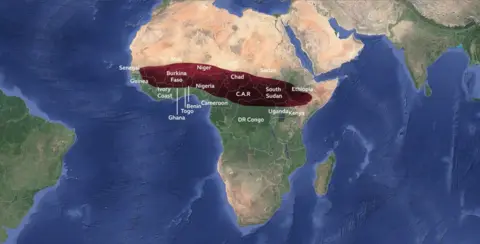ARTICLE AD BOX
Njoroge Muigai & Anne Okumu
BBC News, Koboko

 BBC
BBC
Mustafa Gerima, nicknamed "Mr Shea", wants Ugandans to understand the value of shea nuts
A former biology teacher-turned-environmentalist is on a crusade in Uganda to save the once-flourishing trees from which shea butter is made - the cosmetic known as "women's gold".
Mustafa Gerima wants local communities to stop chopping down the trees to make charcoal - which they say is more profitable than the oil, also used in cooking, that is extracted from its fruit.
He gave up teaching to dedicate himself to the trees when he returned home six years ago and was shocked to find the Mount Kei Central Forest Reserve, once lush with wild shea trees, had been turned into a near-barren expanse dotted with stumps.
Now nicknamed "Bwana Shea" or Mr Shea, he walks from village to village in the north-west of the country rallying people to protect what he sees as a vanishing treasure.
Local people, he said, had lost interest in the trees and began chopping them down as farmers were experiencing failed harvests.
"Thirty years ago, the shea nut tree had a pattern of its production. It flowered in December then by the time it reached April, it would be ready," Mr Gerima told the BBC.
"But now because of climate change there is this prolonged drought. Hence it affects the production of shea nuts."
Uganda loses the equivalent of 140,000 football pitches of forest cover each year
Mount Kei Central Forest Reserve was once full of shea nut trees like this
The growing popularity of charcoal from the shea nut tree has made the situation worse. It is said to burn for longer than other charcoal.
"Our community is affected by poverty. So they look at the tree as a cheap alternative source of income," Mr Gerima said.
Uganda is losing an estimated 100,000 hectares (250,000 acres) of forest cover each year, and a significant portion of that includes shea nut trees, according to the country's environment ministry.
Shea trees grow in the wild from West to East Africa - a vast strip known as the "shea belt". But the shea tree population has dramatically plummeted in recent year, it says.
This loss, combined with the poor harvests, has had a direct impact on people like Mariam Chandiru, a local shea butter producer for many years in the northern town of Koboko.
"We would get good money to take our children to school and take care of our families. But now my business is collapsing, it is a huge setback," she told the BBC.
"I used to sell up to five jerry cans of shea oil a week, right now I can only fill two jerry cans at most."
It has traditionally been women who have gathered the nuts of the shea tree to produce Nilotica shea butter, prized globally for its cosmetic and culinary uses.
Professor John Bosco Okullo, a leading agroforestry expert from Uganda's Makerere University who has been studying shea nut trees for more than two decades, also blames years of widespread insecurity for the problems.
"In the 1990s, communities used to own and protect the shea trees," the academic, who is part of a European Union project aiming to conserve and utilise the tree, told the BBC.
This was before much of the north of the country was ravaged by a rebel group called the Lord's Resistance Army (LRA), led by Joseph Kony, whose fighters were notorious for abducting children - forcing the boys to become fighters and keeping the girls as sex slaves.
The rebels have largely been wiped out, but nearly 20 years of conflict drove people to leave their villages and find safety in camps.
Other communities were affected by dangerous cattle raids - also leading to the displacement of thousands of people in the early 2000s.
"After cattle raiding and civil unrest by the Lord's Resistance Army displaced people, the sense of ownership was lost," said Prof Okullo
"When people returned, they adapted to short-term gains like charcoal burning."
Uganda's shea butter is renowned for its superior quality
Experts say shea nut trees are not flowering and producing fruit the way they used to
Prof Okullo agrees with Mr Gerima that climate change has further exacerbated the situation.
"The productivity has gone down. The trees are not flowering and fruiting the way they used to. Rain fluctuation has disrupted the shea tree's natural cycles," he said.
Rapid urban expansion is another threat.
"Most of these places which used to have shea trees now have new districts, new hospitals, schools," Prof Okullo said.
"You find the shea trees are being cut for development. We need affirmative planting. Otherwise, if we are waiting for natural regeneration, it is going to be difficult."
Despite what seems like a gloomy outlook, Prof Okullo takes heart from campaigners such as Mr Gerima.
The former teacher's most widely known initiative involved a 19-day, 644km (400-mile) walk in 2020.
He trekked from Uganda's capital, Kampala, to the United Nations Environment Programme (Unep) headquarters in Nairobi, capital of neighbouring Kenya.
"Right now, there are a lot of NGOs mobilising communities," Prof Okullo said.
"People are planting new trees and protecting those regenerating from stumps.
"Some are even using grafting techniques to shorten the juvenile phase - it used to take 15 to 20 years before fruiting, now some trees are fruiting much earlier."
To meet rising demand and support sustainable supply chains, the professor and his colleagues are embracing technology.
"We are teaming up with our colleagues in computer science and physics to use Artificial Intelligence so that we can map the mature shea trees and try to project the yield," he said.
The Ugandan government has also recognised the vulnerability of the shea nut tree. In 2023, it made the cutting down of trees for charcoal illegal.
But enforcement has been patchy.
"There was a presidential order to stop cutting shea trees, but it's been difficult to implement," Prof Okullo said.
"The demand for charcoal is highest in urban areas. Those who cut the trees aren't the ones using the charcoal. We need to provide alternative energy sources for cities to reduce the demand."


Seedlings of shea nut trees are being grown and planted out again in the wild
For Mr Gerima, it remains a personal issue.
"Seeing people cut the tree has always caused me a lot of pain in my heart," he said.
He continues his long walks to raise awareness, speaking to local councils, organising planting drives.
"This must not be one man's issue - it must bring in a concerted effort, a collective responsibility."
His next steps include launching a grassroots tree-monitoring initiative and partnering with schools to integrate conservation into the local curriculum.
He says his mission is not just to save a tree but to preserve a way of life.
"We need to think about our future generations. If they come and only find stumps, what will they think of us?"


Shea trees grow in the wild from West to East Africa - an area known as the "shea belt"
You may also be interested in:

 Getty Images/BBC
Getty Images/BBC

 2 months ago
97
2 months ago
97








 English (US) ·
English (US) ·